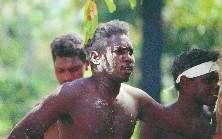| Ancient canoes and ocean travel
Peoples of Oceania arrived in the area from Asia at several different periods.Human colonisation of Australia, by hunters and gatherers, began at least 60,000 years ago and involved crossing at least 85 km of open water between the islands of eastern Indonesia and Australia. These are the oldest sea crossings known in human pre-history but the nature of the craft used is unknown.
Agricultural populations, with skilled techniques of canoe navigation, commenced colonisation of Island Southeast Asia, western Melanesia and the Central Pacific, ca. 3,500–4,000 years ago. New Zealand was settled less than 1, 000 years ago. This massive maritime dispersal of closely related people was made possible with the use of dug-out canoes, presumably equipped with an outrigger and sail. |
|
Canoes enabled the early peoples of Oceania to travel to nearby islands, fish in different marine zones, conduct long sea voyages for exploration, and carry sufficient people and supplies for subsequent colonisation.
As knowledge of star and moon movements, wind systems, currents and swells, and ocean geography increased, navigational skills also improved. In some societies, this was accompanied by significant developments in boat design/construction, and religious practices associated with boat building and safe sea travel. |
 |
Canoe travel linked networks of islands, facilitating the exchange of food, artefacts, dance, song, language, life experiences and knowledge. Partnerships, marital ties and alliances were established between islands. Different tool types, instruments, skills, institutions and beliefs gradually dispersed over large areas greatly influencing local economic, social and political systems.
Language
Knowledge of local marine geography, marine species and habits, fishing technologies, tidal movements, and seafaring, is the result of years of experience passed on from the elders to the young and refined through time. It is embedded in the language and shared by those who speak it.
|
In Oceania many languages are spoken. These languages can be divided into two main language groups: Austronesian (who speak Oceanic languages) and Papuan (people from New Guinea who speak Papuan languages). In Australia, there is one language group, Australian, which is spoken by indigenous Australians.
Social change and spread of English, French and the pidgins as ‘greater' languages, has weakened many indigenous languages. In Australia, for instance, there were about. 250 languages spoken in 1788; now there are only about 50. |
 |
Indigenous people of the Pacific classify plants and animals in ways which reflect how they view their environment. Many criteria are used to classify marine life including general morphology, behaviour and ecological adaptations, practical use, ritual restrictions, and methods used in capture. They name a wide variety of marine creatures from all marine zones illustrating the extent of their knowledge and their relationship with the marine environment.
On Waya Island in the Yasawa Group of Western Fiji, upwards of 700 marine animals are classified and named in the ‘Wayan' language. They distinguish ca. 500 kinds of fish or fish-like animals (ika), over 140 molluscs with shells (cici), ca. 40 decapod crustaceans (Manumanu qwaqwa), and several smaller life forms.
Religion
In various regions of Oceania, people believe in the power of supernatural beings, spirits, the dead and ancestors. In Micronesia and Polynesia, religion involve cults of gods and heroes. In many areas, non-Christian religious beliefs remain strong and are reflected in regional artistic production. The first Europeans introduced their own religious beliefs which were based on Christianity which was enthusiastically taken up in many areas and is still central in people's lives.
In many Oceanic societies rituals are used to try to influence weather, and ensure fishing equipment is effective and fishing trips are successful. Spirits or gods are also sometimes addressed to enhance the fisherman's strength and vision while fishing.
In the Central Caroline Coral Islands, for example, they believe in spirits of the sea. It is thought that two spirits, Soalal and Mar, frequently take peoples souls when they die and keep them to live beneath the sea. The Mar ghost is good and communicates with the living. The Soalal ghost is bad (malevolent) and causes illness ashore or misfortune to those at sea. People who died a bad death (e.g., during child birth or pregnancy; accident) were in the past often buried at sea to minimise their chance of becoming a bad land ghost. They were wrapped in weighted mats as an offering to placate the good Soalal ghost.
Myths Aboriginal Australia
There are many myths associated with the ocean and its creatures. Myths often explain the origins of customs and features of the landscape. They form an important part of cultural knowledge, power and identity. The following myth explains why dugongs live in the ocean
|
The dugong, the cockatoo and the chicken hawk
|
The dugong and her brothers (the cockatoos) camped at the mouth of the river where food was plentiful. In the heat of the day, the dugong fell asleep among the rushes while her brothers went off hunting. The chicken hawk, who was a very lazy bird, set dry grass alight to flush out small animals to eat. The fire spread to the rushes burning the dugong as she slept.
The chicken hawk realised his mistake and fled because the cockatoos who were famous fighters, would surely punish him. The brothers returned to find their sister close to death. They located the chicken hawk and beat him severely. He would never go near the shore again. The brothers returned to the river but their sister had gone. She had swum out of the swamp down the river to the sea where she would be safe. Since that day the ocean is home to the dugong and her descendants. |
 |
|
|